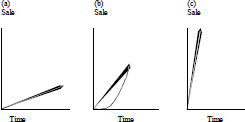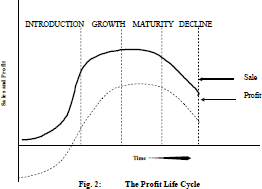Product Life Cycle – Most products have a limited profitable life. This unit will give you a complete picture of what happens from the time a new product is introduced till it declines and will show you how the decline can, to a certain extent, be postponed. Product development involves careful planning and implementation.
Sometimes organizations revive declining products by modification or else they follow several steps ranging from identification of market opportunity to launching of new products to replace the declining products. The greater the competitiveness of markets, the greater the need for product development.
The Product Life Cycle Concept
A company that introduces a new product naturally hopes that the product will contribute to profits and provide consumer satisfaction for a long period of time.
This, however, does not always happen in practice. So, progressive organizations try to remain aware of what is happening throughout the life of the product in terms of sales and the resultant profits.
1. The introductory stage
Let us start thinking from the very beginning about what happens when a new product goes to the market.
The figure above gives three alternatives as to the likely sales trend. If the product is well-designed, the sales would not increase slowly but would shoot up after some time as in:
(a) Rarely would there be a case where they would shoot up.
(b) A poorly designed product may experience a slow skyrocket as in (a).
Thus, (b) represents a suitable sales trend for a new product. This stage is called the ‘introduction’ or ‘innovation’ stage in the life cycle of a product.
Since the product has just been introduced, it is natural to expect that it will take some time before the sales pick up. There are some prerequisites for that too.

The product must be brought to the notice of the customer. It must be available at the distribution outlets and all this takes some time. Therefore, a likely picture of the sales trend in this stage would be (b) as given in the figure above.
Read Also: Classes of Wholesalers in Marketing
2. The growth stage
If the product launch is successful, the sales must start picking up or rise more rapidly. The next stage is known as the ‘growth stage’.
Here, the sales would climb up fast and the profit picture will also improve considerably. This is because the cost of distribution and promotion is now spread over a larger volume of sales.
As the volume of production increases, the manufacturing cost per unit tends to decline. Thus, from the point of view of product strategy, this is a very critical stage.
3. The maturity stage
It is too optimistic to think that sales will keep shooting up. At this stage, it is more likely that the competitors become more active. In case your product is a novel one, by now competitors will come out with a similar product in the market to compete with yours.
Therefore, the sales are likely to be pushed downwards by the competitors while your promotional efforts would have to be increased to try and sustain the sales.
Thus, the sales reach a plateau. It is called the ‘maturity stage’ or ‘saturation’. At this point, it is rocket science to push sales up.
With regard to the ‘profit’ picture, the profits are likely to stabilize or start declining as more promotional effort has to be made now to meet competition.
Unless you have the largest market share with your product and it needs no extra push in the market.
4. The decline or obsolescence stage
The sales are likely to decline and the product could reach the ‘obsolescence’ stage. Prevent this obsolescence and avoid the decline.
This decline that generally follows would be due to several reasons such as consumer changes and tastes, improvement in technology, and the introduction of better substitutes. It is the stage where the profits drop rapidly, and the last level emerges.
Retaining such a profit after this stage may be risky, and certainly not profitable to the organization.
Read Also: The Role of Retailers in the Marketing of Goods

Marketing Mix at Different Stages
At the introductory stage, we have to increase and thus spend a lot on physical distribution and promotion. It is because we have to create awareness and acceptance of our product. We must also increase its availability.
Very often in this country, it is noticed that a product is advertised but is not available at the distribution outlets. It is a waste of promotional expenses. We must make optimum use of the available resources of the organization. Thus, distribution should be arranged before the product is launched.
In any case, in these two areas, substantial amounts would have to be spent. We have to also counter the reluctance of customers to change their established patterns and make them purchase our product, particularly if it is of a novel nature. As against this, if it is a novel one, people may even buy it out of sheer ‘curiosity’.
Next is the growth stage, when the sales shoot up and we are satisfied with the profit generated by the product; competitors will now enter the market and perhaps offer new product features.
Therefore, we may have to think of improving our product so that we do not reach the ultimate ‘decline’ stage too quickly. The promotional expenditure is maintained at the same level or is raised slightly in order to meet competition.
We now come to the next level called the maturity stage. This stage generally lasts longer than the other stages and poses problems for the management in maintaining the sales level. Actually, there is a slowdown in the growth rate of sales in case of such mature products.
The decline can be arrested by improvements in the product and promotion. We should, however, at this time, seriously think in terms of a new product mix, that is, the elimination or redesign of the current product within the near future.
Finally, the decline stage catches up. The decline may be slow or rapid. It may be due to better substitute products, better competition, technological advances with which we have not kept up, and several other reasons.
Such a product now proves expensive for the organization. One must, therefore, be willing to consider the elimination of such marginal or unprofitable products. Eventually, the last weapon is to reduce the price.
This is dangerous because this is a very crucial time when an extra promotional effort is required to be put in to prop up the product’s sales. Reducing the price may soon land the company in a loss situation.
Options in the Decline Stage
Having considered the product life cycle and the inevitability of product decline, the question which comes to one’s mind is what should be done to avoid or postpone this decline.
Consider some of the following points to avoid a decline:
- Improve product quality
- Add new product features resulting in extra benefits
- Penetrate new market segments
- Give incentives to distribution channels
- Expand the number of your distribution channels; and
- Improve advertising and sales effort.
Perhaps, the answer lies in the word ‘innovation’. That is why it is sometimes said that innovation is the lifeblood of marketing. Innovation can be in any of the 4Ps of marketing.
In connection with the product, it would mean quality improvement or improvement in features. Ultimately, a time may come when the product will be removed from the product mix.
Read Also: Functions and Types of Retailers in the Marketing of Goods
